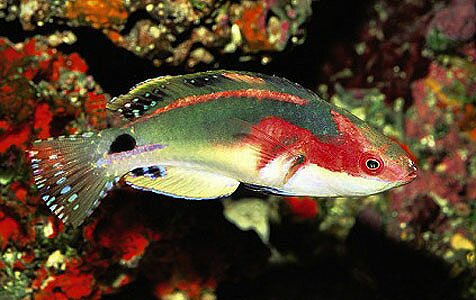Cirrhilabrus
From Microcosm Aquarium Explorer

Cirrhilabrus exquisitus, Exquisite Fairy Wrasse. Scott W. Michael
Family: Labridae
Species in Genus Cirrhilabrus:
- Blackmargin Fairy Wrasse
- Bluehead Fairy Wrasse
- Exquisite Fairy Wrasse
- Lined Fairy Wrasse
- Longfinned Fairy Wrasse
- Lubbock’s Fairy Wrasse
- Redfin Fairy Wrasse
- Redfinned Fairy Wrasse
- Redhead Fairy Wrasse
- Scott’s Fairy Wrasse
- Tono’s Fairy Wrasse
- Yellowfin Fairy Wrasse
- Yellowflanked Fairy Wrasse
FAIRY WRASSES
The fairy wrasses can offer both breathtaking beauty with astonishing color patterns and eminently peaceable dispositions, making them ideally suited to the reef aquarium. The smaller fairy wrasses are a good choice for the beginning hobbyist, while larger individuals more often succumb to the rigors of capture and shipping stress.
With the possible exception of small, delicate shrimp species (e.g., Periclimenes), they do not harm invertebrates. They do best in a peaceful community tank, but some can be kept with moderately aggressive fishes, but should be added to the tank before the aggressors. Fairy wrasses are shy when initially introduced to the aquarium, often hiding for several days. If a peaceful acclimation period is provided, they usually become quite brazen, even to the point of nipping or lying on the aquarist’s hand or forearm as he or she cleans the aquarium. If they are introduced to a tank already harboring belligerent or territorial fishes, they typically stay hidden and end up starving to death or succumbing to disease.
Male fairy wrasses will fight each other and may display toward, but rarely kill, other fish species added after the wrasses are acclimated. They are most likely to behave aggressively toward closely related species like flasher wrasses (Paracheilinus) or small, docile species. If you are keeping male Cirrhilabrus species with more passive zooplanktivores, the fairy wrasses should be the last fishes introduced. If, on the other hand, you plan to keep them with potentially pugnacious tankmates, they should be the first fishes in the aquarium.
If you want to keep more than one Cirrhilabrus, add a harem consisting of one male and several females. It is important to introduce all harem members simultaneously or to add the females first. After the females have adjusted to the tank, add the more aggressive male. (Do not wait too long to do this or one of the females may change sex.) Groups will have to be kept in a larger aquarium (100 gallons [380 L] or more). In small tanks, even females may not get along, or males may pester females to death.
Male fairy wrasses often change colors in captivity if they are not housed with conspecifics (the male’s color [and possibly his gender] will begin to revert back to that of the female). They appreciate good water movement, numerous hiding places and plenty of swimming room. The shallow-water species will have no problems adjusting to the high light levels characteristic of small-polyped stony coral aquariums, while deep-water species adapt more quickly if placed in tanks with less intense illumination. Note: deep-water forms can be kept successfully in high light conditions, but may take longer to acclimate.
Fairy wrasses are very good jumpers. Be careful when working in the tank or when extinguishing the lights—times when nervous fishes tend to flee upward. Ambient light levels should be reduced gradually so that you do not frighten them. They are fairly disease-resistant. Feed two or three times a day to ensure they do not become emaciated and subsequently perish, and offer a varied diet that includes color-enhancing foods. If the fish’s stomach or back begins to look pinched, feed more often.
Carpet anemones (Stichodactyla species) are a threat to fairy wrasses, as these invertebrates have been known to capture and consume smaller wrasses such as these at night.
| Family | Labridae + |
| Image credit | SWM + |
| Reference | A PocketExpert Guide to Reef Aquarium Fishes + |
| Text credit | SWM + |








